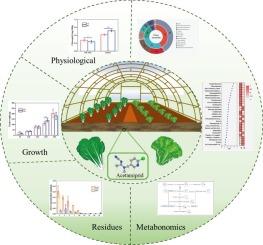Comprehensive effects of acetamiprid uptake and translocation from soil on pak choi and lettuce at the environmental level
IF 4
1区 农林科学
Q2 BIOCHEMISTRY & MOLECULAR BIOLOGY
引用次数: 0
Abstract
Acetamiprid (ACE) is widely used in agriculture to control pests. However, its accumulation in soil and subsequent translocation to plants can impact plant growth and development through mechanisms that remain unclear. This study evaluated the comprehensive effects of residual ACE from soil on cultivated pak choi and lettuce at environmental levels. Results showed that more than 90 % of ACE residues in the soils dissipated within 14 days. The average root concentration factor (RCF) values of pak choi and lettuce were 1.442 and 0.318, respectively, while the average translocation factor (TF) values were 2.145 for pak choi and 5.346 for lettuce. Seedling height increased by 6.32 % in pak choi but decreased by 8.54 % in lettuce. Furthermore, chlorophyll content decreased by 14.6 % in pak choi and increased by 23.7 % in lettuce. Non-targeted metabolomics analysis showed significant disturbances in carbohydrates, amino acids, and secondary metabolite levels. Additionally, KEGG pathway analysis revealed the down-regulation of amino acid metabolites in both vegetables, alongside an up-regulation of flavone and flavonol biosynthesis in pak choi. This research enhances the understanding of the effects and underlying metabolic mechanism of ACE on different vegetables.

啶虫脒从土壤中吸收和转移对白菜和莴苣环境水平的综合影响
啶虫脒(ACE)被广泛用于农业防治害虫。然而,它在土壤中的积累以及随后向植物的转移会影响植物的生长和发育,其机制尚不清楚。本研究评估了土壤中残留的乙酰甲胺磷在环境水平上对栽培蕹菜和莴苣的综合影响。结果表明,土壤中 90% 以上的 ACE 残留物在 14 天内消散。白菜和莴苣的平均根浓缩因子(RCF)值分别为 1.442 和 0.318,而平均易位因子(TF)值分别为 2.145 和 5.346。白菜的苗高增加了 6.32%,而莴苣则减少了 8.54%。此外,白菜的叶绿素含量减少了 14.6%,而莴苣则增加了 23.7%。非靶向代谢组学分析表明,碳水化合物、氨基酸和次生代谢物水平受到显著干扰。此外,KEGG 通路分析表明,两种蔬菜的氨基酸代谢物都出现了下调,而白菜中黄酮和黄酮醇的生物合成则出现了上调。这项研究加深了人们对 ACE 对不同蔬菜的影响及其代谢机制的了解。
本文章由计算机程序翻译,如有差异,请以英文原文为准。
求助全文
约1分钟内获得全文
求助全文
来源期刊
CiteScore
7.00
自引率
8.50%
发文量
238
审稿时长
4.2 months
期刊介绍:
Pesticide Biochemistry and Physiology publishes original scientific articles pertaining to the mode of action of plant protection agents such as insecticides, fungicides, herbicides, and similar compounds, including nonlethal pest control agents, biosynthesis of pheromones, hormones, and plant resistance agents. Manuscripts may include a biochemical, physiological, or molecular study for an understanding of comparative toxicology or selective toxicity of both target and nontarget organisms. Particular interest will be given to studies on the molecular biology of pest control, toxicology, and pesticide resistance.
Research Areas Emphasized Include the Biochemistry and Physiology of:
• Comparative toxicity
• Mode of action
• Pathophysiology
• Plant growth regulators
• Resistance
• Other effects of pesticides on both parasites and hosts.

 求助内容:
求助内容: 应助结果提醒方式:
应助结果提醒方式:


